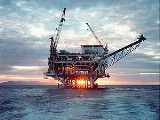
Offshore oil and gas in California
Encyclopedia
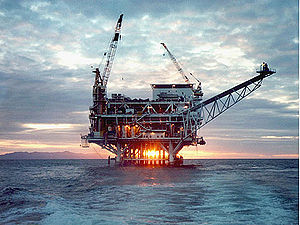
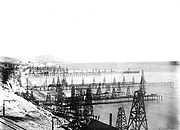
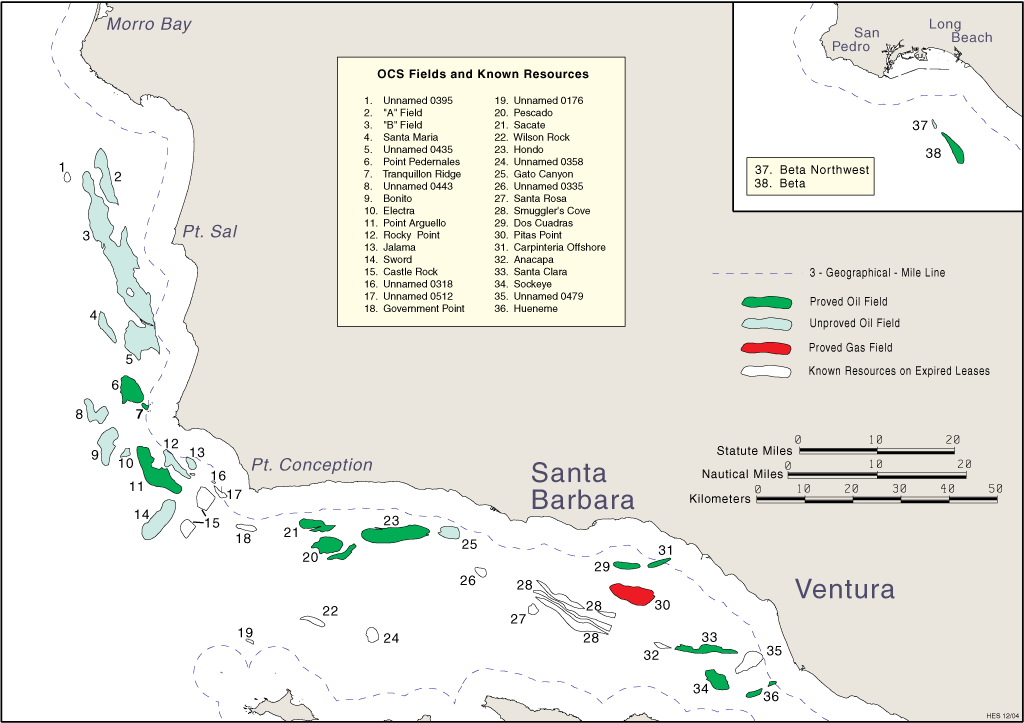
Notable offshore fields include the Ellwood Oil Field
Ellwood Oil Field
Ellwood Oil Field and South Ellwood Offshore Oil Field are a pair of adjacent, partially active oil fields adjoining the city of Goleta, California, about twelve miles west of Santa Barbara, largely in the Santa Barbara Channel...
and the Wilmington Oil Field
Wilmington Oil Field
The Wilmington Oil Field is a large petroleum field in Los Angeles County in southern California in the United States in terms of cumulative oil produced. Discovered in 1932, it is the third largest oil field in the United States...
, both of which are partially onshore and partially offshore, and the large Dos Cuadras Field
Dos Cuadras Offshore Oil Field
The Dos Cuadras Offshore Oil Field is a large oil and gas field underneath the Santa Barbara Channel about eight miles southeast of Santa Barbara, California. Discovered in 1968, and with a cumulative production of over 260 million barrels of oil, it is the 24th-largest oil field within California...
in the Santa Barbara Channel
Santa Barbara Channel
The Santa Barbara Channel is a portion of the Pacific Ocean which separates the mainland of California from the northern Channel Islands. It is generally south of the city of Santa Barbara, and west of the city of Ventura....
, which is entirely in the federal zone.
State offshore seabed in California produced 37400 barrels (5,946.1 m³) of oil per day, and federal offshore tracts produced 66400 barrels (10,556.8 m³) of oil per day in November 2008. State and federal offshore tracts together made up 16% of the state's oil production.
Pre-oil industry
Knowledge of the probable existence of oil off the coast of California dates back to the early European explorers who noted oil slicks in the Santa Barbara channelSanta Barbara Channel
The Santa Barbara Channel is a portion of the Pacific Ocean which separates the mainland of California from the northern Channel Islands. It is generally south of the city of Santa Barbara, and west of the city of Ventura....
(see Coal Oil Point seep field
Coal Oil Point seep field
The Coal Oil Point seep field offshore from Santa Barbara, California is a petroleum seep area of about three square kilometers adjacent to the Ellwood Oil Field, and releases about 40 tons per day of methane and about 19 tons of reactive organic gas , about twice the hydrocarbon air pollution...
). In 1792, when the English explorer James Cook
James Cook
Captain James Cook, FRS, RN was a British explorer, navigator and cartographer who ultimately rose to the rank of captain in the Royal Navy...
anchored his ship in the Santa Barbara Channel, his navigator George Vancouver
George Vancouver
Captain George Vancouver RN was an English officer of the British Royal Navy, best known for his 1791-95 expedition, which explored and charted North America's northwestern Pacific Coast regions, including the coasts of contemporary Alaska, British Columbia, Washington and Oregon...
wrote that the sea was “... covered with a thick, slimy substance,” and added “... the sea had the appearance of dissolved tar floating on its surface, which covered the ocean in all directions within the limits of our view.”
In 1865, oil geologist Charles Jackson wrote:
- “Off the coast of Santa Barbara. The strong smell of petroleum comes from the sea, the oil floating on the water.”
A description of the oil and gas seeps offshore southern California can be found in a report on the California Division of Oil and Gas's website. The report is accompanied by a map, showing the locations of offshore petroleum seeps from Point Arguello (north of Santa Barbara) to Mexico.
Extension of onshore fields
Offshore drilling began in California in 1896, when operators in the Summerland Oil FieldSummerland Oil Field
The Summerland Oil Field is an inactive oil field in Santa Barbara County, California, about four miles east of the city of Santa Barbara, within and next to the unincorporated community of Summerland...
in Santa Barbara County
Santa Barbara County, California
Santa Barbara County is a county located in the southern portion of the U.S. state of California, on the Pacific coast. As of 2010 the county had a population of 423,895. The county seat is Santa Barbara and the largest city is Santa Maria.-History:...
followed the field into the ocean by drilling from piers built out over the ocean. At least 187 offshore oil wells were drilled in the Summerland Field by 1902. A number of other coastal fields were extended offshore in Santa Barbara, Ventura
Ventura County, California
Ventura County is a county in the southern part of the U.S. state of California. It is located on California's Pacific coast. It is often referred to as the Gold Coast, and has a reputation of being one of the safest populated places and one of the most affluent places in the country...
, Los Angeles
Los Angeles County, California
Los Angeles County is a county in the U.S. state of California. As of 2010 U.S. Census, the county had a population of 9,818,605, making it the most populous county in the United States. Los Angeles County alone is more populous than 42 individual U.S. states...
, and Orange
Orange County, California
Orange County is a county in the U.S. state of California. Its county seat is Santa Ana. As of the 2010 census, its population was 3,010,232, up from 2,846,293 at the 2000 census, making it the third most populous county in California, behind Los Angeles County and San Diego County...
counties, usually by directional drilling
Directional drilling
Directional drilling is the practice of drilling non-vertical wells. It can be broken down into three main groups: Oilfield Directional Drilling, Utility Installation Directional Drilling Directional drilling (or slant drilling) is the practice of drilling non-vertical wells. It can be broken down...
.
The Wilmington Oil Field
Wilmington Oil Field
The Wilmington Oil Field is a large petroleum field in Los Angeles County in southern California in the United States in terms of cumulative oil produced. Discovered in 1932, it is the third largest oil field in the United States...
in Los Angeles
Los Ángeles
Los Ángeles is the capital of the province of Biobío, in the commune of the same name, in Region VIII , in the center-south of Chile. It is located between the Laja and Biobío rivers. The population is 123,445 inhabitants...
and Long Beach
Long Beach, California
Long Beach is a city situated in Los Angeles County in Southern California, on the Pacific coast of the United States. The city is the 36th-largest city in the nation and the seventh-largest in California. As of 2010, its population was 462,257...
was extended offshore into Long Beach Harbor by drilling numerous wells directionally from four artificial islands in the harbor. The drilling islands, owned by the City of Long Beach, are landscaped with palm trees.
Ownership of offshore oil and gas
The issue of state versus federal ownership has a long and contentious history (see TidelandsTidelands
Tidelands are the territory between the high and low water tide line of sea coasts, and lands lying under the sea beyond the low-water limit of the tide, considered within the territorial waters of a nation. The United States Constitution does not specify whether ownership of these lands rests with...
). The US Supreme Court ruled in 1947 that the federal government owned all the seabed off the California coast. However, the US Congress passed the Outer Continental Shelf
Outer Continental Shelf
The Outer Continental Shelf is a peculiarity of the political geography of the United States and is the part of the internationally recognized continental shelf of the United States which does not fall under the jurisdictions of the individual U.S...
Act in 1953, which recognized state ownership of the seabed within 3 nautical miles (6 km) of the shore.
In some cases, the state granted ownership of offshore seabed to the adjacent municipalities. In this way Long Beach
Long Beach, California
Long Beach is a city situated in Los Angeles County in Southern California, on the Pacific coast of the United States. The city is the 36th-largest city in the nation and the seventh-largest in California. As of 2010, its population was 462,257...
was granted ownership of Long Beach Harbor in 1911. When the Wilmington field was discovered, Long Beach contracted with oil companies to produce oil from the city-owned offshore part of the field.
Offshore development
Oil production began from a man-made offshore island off Seal Beach in 1953. The first strictly offshore oil field in California was the Belmont Offshore Field, discovered in 1948 1.6 miles (2.6 km) from the shore of Seal BeachSeal Beach, California
-Neighborhoods:Seal Beach encompasses the Leisure World retirement gated community with roughly 9,000 residents. This was the first major planned retirement community of its type in the U.S...
; production did not begin until 1954 when a man-made island was built in 40 feet of water for drilling and production equipment.
The first of ten federal offshore lease sales in California was held in 1963.
Santa Barbara spill and aftermath
- Main article: 1969 Santa Barbara oil spill1969 Santa Barbara oil spillThe Santa Barbara oil spill occurred in January and February 1969 in the Santa Barbara Channel, near the city of Santa Barbara in Southern California. It was the largest oil spill in United States waters at the time, and now ranks third after the 2010 Deepwater Horizon and 1989 Exxon Valdez spills...
The Union Oil Company discovered the Dos Cuadras oil field in federal waters of the Santa Barbara Channel in 1968, but success turned to disaster in 1969, when large quantities of oil began escaping to the sea floor near a drilling well in the field. The resulting oil slick came ashore along 35 miles (56.3 km) of coastline in Santa Barbara County, and turned public opinion against offshore drilling in California. In response to the oil spill, US Secretary of the Interior Walter Hickel removed 53 square miles (137.3 km²) of federal tracts near Santa Barbara
Santa Barbara, California
Santa Barbara is the county seat of Santa Barbara County, California, United States. Situated on an east-west trending section of coastline, the longest such section on the West Coast of the United States, the city lies between the steeply-rising Santa Ynez Mountains and the Pacific Ocean...
from oil and gas leasing.
Halting new offshore leasing
California, like other states, owns and controls the mineral resources within 3 nautical miles (6 km) of the coast. Leasing California state seabed is controlled by the California State Lands CommissionCalifornia State Lands Commission
The California State Lands Commission is a unit of state government that is responsible for management and protection of natural and cultural resources, as well as public access rights, on some of California's publicly owned lands....
, which halted further leasing of state offshore tracts after the Santa Barbara oil spill in 1969. In 1994 the California legislature codified the ban on new leases by passing the California Coastal Sanctuary Act, which prohibited new leasing of state offshore tracts.
The federal government continued to hold offshore lease sales through 1984. Then the US Congress directed that no federal funds be used to lease additional federal tracts off the coast of California. Congress repeated the moratorium on new leases every year until September 2008, when an appropriations bill passed the House and Senate without the ban; however, no federal lease sales have been proposed for offshore California since the ban was lifted.
A lawsuit by the state of California prevented the federal government from allowing development on 36 federal leases issued before the congressional moratorium. The federal government voided 29 of the contested leases by repaying $1.1 million in lease bonuses; the seven additional federal leases have not been resolved, but remain inactive because of the litigation. The Minerals Management Service estimates that the seven undeveloped leases contain 1000000000 barrel (0.158987295 km³) of recoverable oil and 500000000000 cubic feet (14.2 km³) of recoverable gas.
In 1990, President George H. W. Bush
George H. W. Bush
George Herbert Walker Bush is an American politician who served as the 41st President of the United States . He had previously served as the 43rd Vice President of the United States , a congressman, an ambassador, and Director of Central Intelligence.Bush was born in Milton, Massachusetts, to...
issued an executive moratorium banning new federal leasing through the year 2000 in many offshore areas, including California. In 1998, President Bill Clinton
Bill Clinton
William Jefferson "Bill" Clinton is an American politician who served as the 42nd President of the United States from 1993 to 2001. Inaugurated at age 46, he was the third-youngest president. He took office at the end of the Cold War, and was the first president of the baby boomer generation...
extended the moratorium through 2012. In July 2008, President George W. Bush
George W. Bush
George Walker Bush is an American politician who served as the 43rd President of the United States, from 2001 to 2009. Before that, he was the 46th Governor of Texas, having served from 1995 to 2000....
rescinded the executive order.
Tranquillon Ridge field
Although leasing in state waters has been prohibited since 1994, the law allows exceptions when petroleum under state lands is being drained by nearby wells on non-state tracts; no such exceptions have been made to date. In 2008 both Plains Exploration & ProductionPlains Exploration & Production
Plains Exploration & Production, commonly known by its New York Stock Exchange ticker symbol , is a U.S. petroleum company based in Houston, Texas. A spin-off from Plains Resources, Inc., the company was founded in 2002. Its operations, as of 2009, were all in North America, including California,...
(PXP) and ExxonMobil
ExxonMobil
Exxon Mobil Corporation or ExxonMobil, is an American multinational oil and gas corporation. It is a direct descendant of John D. Rockefeller's Standard Oil company, and was formed on November 30, 1999, by the merger of Exxon and Mobil. Its headquarters are in Irving, Texas...
offered competing proposals to the state to drill wells into Tranquillon Ridge field, offshore Santa Barbara County. The Tranquillon Ridge field lies partly in state and partly in federal waters. Neither proposal entailed additional offshore surface structures. Plains proposed to drill wells directionally from their existing Irene Platform in federal waters. ExxonMobil proposed to drill directionally from wells onshore in Vandenberg Air Force Base
Vandenberg Air Force Base
Vandenberg Air Force Base is a United States Air Force Base, located approximately northwest of Lompoc, California. It is under the jurisdiction of the 30th Space Wing, Air Force Space Command ....
. The Plains Exploration proposal was endorsed by the Environmental Defense Center and by Get Oil Out! On 29 January 2009 the State Lands Commission denied the applications by a 2-1 vote.
In July 2009 Governor Arnold Schwarzenegger
Arnold Schwarzenegger
Arnold Alois Schwarzenegger is an Austrian-American former professional bodybuilder, actor, businessman, investor, and politician. Schwarzenegger served as the 38th Governor of California from 2003 until 2011....
proposed allowing oil production from the state portion of Tranquillon Ridge field, as a way to increase state revenue, which would include a $100 million up-front payment to the state. The provision was defeated in the state legislature. On 3 May 2010, governor Schwarzenegger, reacting to the Deepwater Horizon oil spill
Deepwater Horizon oil spill
The Deepwater Horizon oil spill is an oil spill in the Gulf of Mexico which flowed unabated for three months in 2010, and continues to leak fresh oil. It is the largest accidental marine oil spill in the history of the petroleum industry...
, withdrew his support for the Tranquillon Ridge drilling plan, stating, "I see on TV the birds drenched in oil, the fishermen out of work, the massive oil spill and oil slick destroying our precious ecosystem."
Current activity
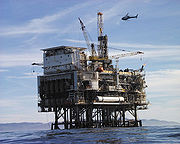
Nine active offshore drilling and production locations remain in state and municipal waters: one platform and one artificial island in the Santa Barbara Channel, and four artificial islands and three platforms from the offshore portion of the Wilmington Oil Field
Wilmington Oil Field
The Wilmington Oil Field is a large petroleum field in Los Angeles County in southern California in the United States in terms of cumulative oil produced. Discovered in 1932, it is the third largest oil field in the United States...
in San Pedro Bay
San Pedro Bay (California)
San Pedro Bay is an inlet on the Pacific Ocean coast of southern California, United States. It is the site of the Port of Los Angeles and the Port of Long Beach, which together form the fifth-busiest port facility in the world and easily the busiest in the Western Hemisphere...
/Long Beach Harbor. The first artificial offshore island, for Belmont Offshore Field, was removed in 1999.
Twenty-three offshore drilling and production platforms remain in federal waters, producing 22 million barrels of oil and 21 billion cubic feet of gas per year (as of 2009).
See also
- Offshore oil and gas in the United StatesOffshore oil and gas in the United StatesOffshore oil and gas in the United States provides a large portion of the nation’s oil and gas supply. Large oil and gas reservoirs are found in the sea nearby Louisiana, Texas, California, and Alaska...
- Offshore oil drilling
- Oil platformOil platformAn oil platform, also referred to as an offshore platform or, somewhat incorrectly, oil rig, is a lаrge structure with facilities to drill wells, to extract and process oil and natural gas, and to temporarily store product until it can be brought to shore for refining and marketing...
- Rigs-to-ReefsRigs-to-ReefsRigs-to-Reefs is a nationwide program developed by the Minerals Management Service of the U.S. Department of the Interior to turn decommissioned offshore oil and petroleum rigs into artificial reefs.-Overview:...
- US offshore drilling debate

